

 Unique, "EB on Breast"
Unique, "EB on Breast"1787 Brasher Doubloon from
The Gold Rush Collection
"BARNACLES OF GOLD"
THE STORY OF DAHLONEGA'S FAMED FINDLEY MINE
Mining at the Findley in the 1920s and 30s
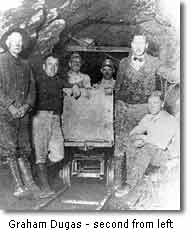 Major
Graham Dugas is usually associated with the Calhoun Mine, where
he made a big strike in the 1940s and made national news. However,
two old photographs show him with miners at the Findley Mine in
the late 1920s. The extent of his involvement there is not known.
Major
Graham Dugas is usually associated with the Calhoun Mine, where
he made a big strike in the 1940s and made national news. However,
two old photographs show him with miners at the Findley Mine in
the late 1920s. The extent of his involvement there is not known.
A decade later, Cornelius O’Kane erected a new mill on the Findley property beside Yahoola Creek. Lester Shelton worked for O’Kane at the time and helped clear out the area around the old mine so the new stamp mill could be built. He hauled sand from a sandbar on the other side of Yahoola Creek to put in the cement of the foundation.
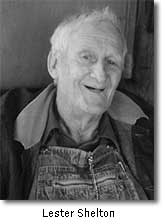 “There
wasn’t much of a road to the Findley at that time, so I helped
work on it with a drag-pan and mule,” he related to this author
in a 1993 interview. “It was real narrow because there wasn’t
much room between Yahoola Creek and the bluffs of Crown Mountain.
When the owners bought a diesel engine to run the mill, nobody thought
they could get it in on that road except for Tal Odum, who said
he would do it.
“There
wasn’t much of a road to the Findley at that time, so I helped
work on it with a drag-pan and mule,” he related to this author
in a 1993 interview. “It was real narrow because there wasn’t
much room between Yahoola Creek and the bluffs of Crown Mountain.
When the owners bought a diesel engine to run the mill, nobody thought
they could get it in on that road except for Tal Odum, who said
he would do it.
“Tal was behind the wheel, and I was standing in the back of his old Chevrolet truck holding on to the engine to keep it from shifting, when the vehicle started to tilt sideways. The weight of the engine was making the tires on one side sink deep into the soft dirt. I jumped off just as the truck started to turn over. I yelled at Tal, but he was already jumping free. We watched helplessly as the truck turned bottom-side up in the middle of the Yahoola!”
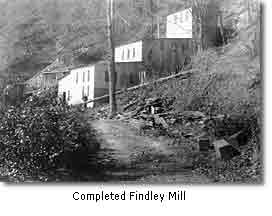 Paul
Early helped move the 10-stamp “Little Findley” mill
from up on Findley Ridge down to the new mill. Other heavy equipment
was moved to the Findley from the Mary Henry gold mine. According
to Early, a tunnel was dug into the base of Findley Ridge with the
intention of striking the historic Findley Chute, but the ore dug
out of the tunnel proved to be of a disappointingly low grade.
Paul
Early helped move the 10-stamp “Little Findley” mill
from up on Findley Ridge down to the new mill. Other heavy equipment
was moved to the Findley from the Mary Henry gold mine. According
to Early, a tunnel was dug into the base of Findley Ridge with the
intention of striking the historic Findley Chute, but the ore dug
out of the tunnel proved to be of a disappointingly low grade.
Playing “Goldball”
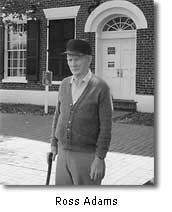 Ross
Adams also worked at the Lockhart and Findley Mines when they were
owned by “Ol’ Man O’Kane.” “My job
was usually shoveling ore with a square-bottomed shovel to feed
the stamps that pounded it into fine dust, but the Findley was a
self-feeder with a hopper that fed ore directly to the stamp mill,”
he related in a 1993 interview with this author. “The crushed
ore went into a sluice box to be washed. The gold was heavier and
fell to the bottom, where it was caught on copper plates coated
with quicksilver.
Ross
Adams also worked at the Lockhart and Findley Mines when they were
owned by “Ol’ Man O’Kane.” “My job
was usually shoveling ore with a square-bottomed shovel to feed
the stamps that pounded it into fine dust, but the Findley was a
self-feeder with a hopper that fed ore directly to the stamp mill,”
he related in a 1993 interview with this author. “The crushed
ore went into a sluice box to be washed. The gold was heavier and
fell to the bottom, where it was caught on copper plates coated
with quicksilver.
“Every week or so we would have what was called a ‘cleanup’ to get the gold. First, the mercury plates were scraped with a piece of hard rubber. Then the mass of gold and quicksilver was put into a round iron container and heated in the blacksmith’s forge. The heat made the quicksilver boil out and caused the gold to melt and run together so that it came out looking like a half a pound of yellow butter. Sometimes it would weigh six or seven pounds, and I remember throwing a good-sized ball of gold back and forth with another fellow like we were pitching a baseball.
“I also drilled with a jackhammer inside the mines and set off dynamite to blast out the rock. There was always a bell set up on the hill that was rung to let everybody know there was dynamite in the hole fixin’ to blow. One time I just barely got out in time, and the blast liked to have knocked me down!”
O’Kane’s new Findley Mill began operations in the summer of 1940 but only operated a couple of years before World War II put a halt to mining. Men were drafted, and dynamite was unavailable. A college student named Hinton Amerson exploring the mill in 1953 found a newspaper dated 1942, suggesting that the mine was still operating at that time.
Col. James Jefferson Findley
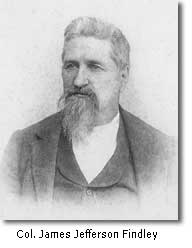 No
history of the Findley Mine would be complete without some information
about the man whose name has come down in history because of its
association with the mining property and the knob of Crown Mountain
still known today as “Findley Ridge.” Since Findley
didn’t purchase the property until 1858, the ridge may not
have had a name when Dr. Matthew F. Stephenson made his famous speech
from the porch of the Lumpkin County Courthouse attempting to dissuade
local miners from leaving to join the 1849 California Gold Rush.
No
history of the Findley Mine would be complete without some information
about the man whose name has come down in history because of its
association with the mining property and the knob of Crown Mountain
still known today as “Findley Ridge.” Since Findley
didn’t purchase the property until 1858, the ridge may not
have had a name when Dr. Matthew F. Stephenson made his famous speech
from the porch of the Lumpkin County Courthouse attempting to dissuade
local miners from leaving to join the 1849 California Gold Rush.
“Why go to California?” he asked them, pointing dramatically toward the small mountain about a half-mile south of the Dahlonega Public Square. “In that ridge lies more gold than man ever dreamt of. There’s millions in it!” The miners who disregarded his words and headed West nevertheless quoted the expression until "There's millions in it" became a popular idiom. Mark Twain further immortalized the phrase by using it in his book, "The Gilded Age."
James Jefferson Findley was born in 1829 and reportedly came to Dahlonega at a young age. A lawyer by profession, he was elected sheriff of Lumpkin County and later represented the county in the Georgia Legislature.
During the Civil War, Findley was a Major in Company D, 52nd Georgia Regiment, C.S.A. (“Boyd Guards”) and afterwards a Colonel who commanded the Lumpkin County Home Guards. He had his headquarters in the 1836 courthouse, which also served as a jail for deserters, bushwhackers, and other military prisoners. In October of 1864, he was the officer in charge who ordered the execution of three Union soldiers, whom he believed to be bushwhackers who had been burning and looting in the area. A month later, Col. Findley and his 1st Georgia State Cavalry Home Guards followed raiding Union troops over the top of Amicalola Mountain and captured them after a skirmish that took place in Bucktown in Gilmer County.
J. J. Findley had three sons by his first wife, Elizabeth Stephens (1825-1879). He married Martha Mathilda Williams (1848-1931) of Dahlonega in 1886. Their only child, Jefferson William Findley, was born in 1887, but Findley did not live to see this son grow up. He died of cancer in 1888. In his obituary published in the March 9, 1888 Dahlonega Signal , he was described as “true to principle, true to friends, a genial, wholesome, liberal, gentleman” who always “wore a cheerful smile.”
The Findley Ridge Roadside Park and Historical Marker
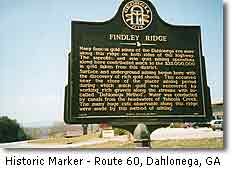 In
1961, a roadside park was created beside Highway 60 where it crosses
Findley Ridge on Crown Mountain. It was located in a hollowed-out
area created when top soil was dug out and hauled away for use as
a base for paving the road. According to Madeleine Anthony, who
wrote a feature article about the Findley Ridge Park for the
Gainesville
Times
, the top soil removed was gold ore, making Highway
60 “the only one anywhere with a gold base.”
In
1961, a roadside park was created beside Highway 60 where it crosses
Findley Ridge on Crown Mountain. It was located in a hollowed-out
area created when top soil was dug out and hauled away for use as
a base for paving the road. According to Madeleine Anthony, who
wrote a feature article about the Findley Ridge Park for the
Gainesville
Times
, the top soil removed was gold ore, making Highway
60 “the only one anywhere with a gold base.”
Anthony related another piece of interesting information. “While hauling off the gold-ore-top-soil,” she wrote, “workers uncovered a gold vein only 10 feet from where a tunnel ended. Had the miner, in 1850, continued his tunnel 10 feet more, he would have felt like a millionaire overnight.”
For some years visitors stopped at the roadside park to read the Findley Ridge Historical Marker and enjoy the scenic view of the town below with its backdrop of blue-green mountains. Local residents sometimes took picnic lunches to eat on the concrete tables or had cookouts on the outdoor grills. While Highway 60 was widened, however, the small roadside park was destroyed. The Findley Ridge Historical Marker put up by the Department of Natural Resources was missing for a number of years but has now been replaced and may be seen on the right side of the road as motorists reach the summit of Findley Ridge headed into Dahlonega.
Attempts have been made in recent years to open the historic site to those interested in viewing the remaining artifacts, but the costs of making the area safe and accessible were prohibitive. At this time the Findley property is privately owned and is not open to the public.